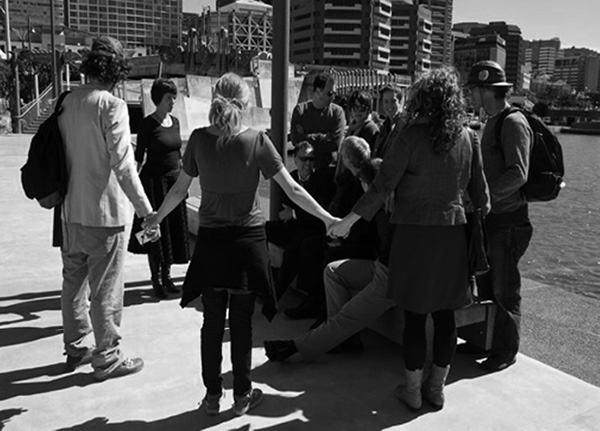
PRODUCTIVE BODIES
first performed on March 12th 2012
New Zealand International Festival of the Arts, on the streets, parks, alley and walk ways of the Central Business District and City Gallery, Wellington City, New Zealand
performed five times in 2012
MARK HARVEY
Sophie Jerram, Mark Amery, anonymous participants
Auckland, Aotearoa, New Zealand
120414667m120414667.120414667h120414667a120414667r120414667v120414667e120414667y120414667@120414667a120414667u120414667c120414667k120414667l120414667a120414667n120414667d120414667.120414667a120414667c120414667.120414667n120414667z
lettingspace.org.nz/productive-bodies
markharvey.co.nz
PRODUCTIVE BODIES
MARK HARVEY
“Productive Bodies” was a major performance art project that used group behavior, public interaction, community involvement, movement and humour. “Productive Bodies” aimed to examine the usefulness, workfulness and worklessness of individuals and groups in society. It explored what it means to be productive, equating community service with civil service, acknowledging the significant redundancies occurring in the New Zealand government services at present. The project aimed to make a minor difference in the daily grind of workers and support those who have lost their jobs and help them build self-confidence, under the current political climate, without being an overt protest performance.
Workshops were held at City Gallery Wellington 10am-12pm every day for four days. People who were unemployed, artists, between jobs, or not in full time employment were welcome to participate at any time during the week. The performers then left the gallery as a group at 1pm performing throughout the city until 3pm. The path and activities of the performance were determined by the group and were continually negotiated and evolved with a flat-level management strategy, under Harvey’s guidance, in contrast to how most workplaces operate in the Western world.
All performances engaged within the precinct of government departments in Wellington, where in the same week the government announced thousands of job lay-offs. The performers became the nicest and most useful performers in New Zealand. Activities performed included providing free wind and sun shields, protective shields and state radio and TV schedules for passersby (that the government was about to make cuts to). The performers also helped people cross streets with firemen’s lifts, cleaned things in the streets, gave free tours around public sculptures and clapped and cheered government workers entering and exiting their workplaces. The performers received many thank you’s, laughs, smiles, letters of support and gratitude, and generated much local and national debate around how we value work, investment and citizenry, in addition to critical reflections on the current government’s neo-liberal austerity measures.